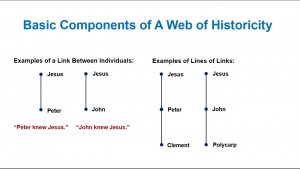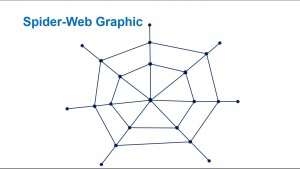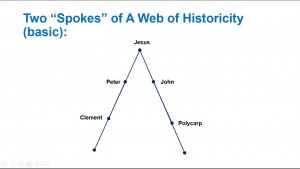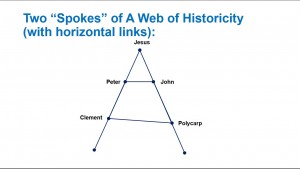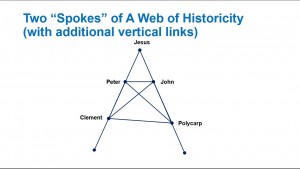Debate: External Evidence for Jesus – Parts 5B and 5C
Joe Hinman’s fifth argument for the existence of Jesus based on external evidence is presented in two sections of his post on the Web of Historicity:
5B. Big Web of Historicity
5C. Jesus Myth Theory Cannot Account for the Web
The fifth argument for the existence of Jesus can be summarized in terms of a single premise:
1.There is a web of historicity.
Therefore:
2. It is probable that Jesus of Nazareth was a flesh-and-blood historical person.
Given this very simple summary, the argument appears to be illogical, because the conclusion does not follow logically from the premise. We can enhance the premise a bit to make the argument less illogical:
1A. There is a web of historicity that has Jesus of Nazareth at it’s center.
Therefore:
2. It is probable that Jesus of Nazareth was a flesh-and-blood historical person.
With this modification, the premise at least mentions Jesus of Nazareth and so appears to be more relevant to the conclusion, which is about Jesus of Nazareth. However, the argument is still illogical, even with this enhancement of the key premise.
We can, however, make the argument logical by adding a generic “Web Warrant” premise that connects the key concept in premise (1A), namely the concept of “a web of historicity”, to the conclusion:
1A. There is a web of historicity that has Jesus of Nazareth at it’s center.
WW. IF there is a web of historicity that has a person X at it’s center, THEN it is probable that person X was a flesh-and-blood historical person.
Therefore:
2. It is probable that Jesus of Nazareth was a flesh-and-blood historical person.
This clarified summary of the fifth argument shows that Hinman has three main tasks in order for his fifth argument to be successful:
- Provide a clear explanation of the concept of “a web of historicity”,
- Provide sufficient evidence to show that premise (1A) is true.
- Provide good reasons showing how and why “a web of historicity” provides strong evidence for the existence of a person who is at the center of such a web.
Unfortunately, Hinman accomplishes NONE of these three tasks, and so this fifth argument is unsuccessful, at least based on the evidence and reasons that Hinman has provided in his post on this fifth argument for Jesus.
Although Hinman failed to provide a clear explanation of the concept of “a web of historicity”, and thus he necessarily failed at the other two main tasks of supporting the two premises of his argument, I will try to help him out and begin to analyze and clarify the central concept.
I expect, however, that Hinman will need to either (a) accept the clarifications that I suggest, and expand upon them further, or else he will need to (b) provide an alternative analysis and explanation of this key concept. Unless and until Hinman can provide a clear explanation of this metaphor, the premises of his fifth argument will remain unclear and unsupported.
What are the basic components of “a web of historicity”? Hinman hints at the components of such a web:
There are links between individuals that tie our knowledge back to Jesus. …There are many such lines of links; they from [sic] a huge web because they are all interconnected.
Thus, “a web of historicity” is made up of individuals (i.e. people) , and links between individuals. We know that one of the individuals in the “web of historicity” that Hinman argues for is: Jesus of Nazareth. What other individuals are part of this alleged web? Hinman mentions two of the original disciples of Jesus in the opening of his section called “Big Web of Historicity”: John and Peter. At the end of the second paragraph of this section, Hinman provides us with a clear and relevant example of a “link between individuals”:
Peter knew Jesus.
So, we can construct one clear and relevant component of the alleged “web of historicity” for which Hinman is arguing. It contains two individuals and a link between the individuals:
JESUS—PETER
Presumably, Hinman would also claim the same thing about John:
John knew Jesus.
So, we have a second component of the alleged “web of historicity”:
JESUS—JOHN
Hinman also asserts that Clement of Rome “most probably” knew Peter, so this additional individual has a link to Peter, and we can now form an example of an alleged line of links:
JESUS—PETER—CLEMENT
Hinman also asserts that Polycarp had a “connection” with John:
John taught Polycarp.
So, we have a second alleged line of links going back to Jesus:
JESUS—JOHN—POLYCARP
Here is a graphical representation of links between individuals and lines of links (click on the image for a clearer view of the graphics):
In a spider web, or in a simplified graphical representation of a spider web, there are lines that radiate out from the center of the web, like the spokes of a bicycle wheel radiating out from the hub at the center of the wheel. Here is a simple graphical representation of a spider web (click on the image for a clearer view of the spider-web graphic) :
The two lines of links that we have presented so far would presumably constitute two “spokes” or lines of links with Jesus being at the center of the hypothetical web:
But two “spokes” don’t look like a part of a spider web. To get something more like a spider web, we need to add some horizontal “links” between individuals at the same level:
Hinman asserts that in a Web of Historicity with Jesus at the center, the lines of links form “a huge web because they are all interconnected.” This might be a bit of hyperbole, but if we take this assertion literally, then lots of other connections between individuals in this alleged Web of Historicity would exist, such as additional links between the inner level (i.e. Jesus’ immediate disciples) and the next level (e.g. the disciples of the disciples):
Note that in the above diagram of one small piece of a hypothetical “Web of Historicity” (hereafter: WOH)there are eight different links or connections between individuals. Furthermore, since a link can in some cases go one direction but not in the reverse direction, the eight links in the above diagram actually represent SIXTEEN different possible relationships between these five individuals. Thus, in order to SHOW that this small part of a WOH actually exists, one might need to SHOW that sixteen different relationships actually exist between these five people. I’m not sure that Hinman is aware of the degree of complexity and difficulty involved in showing the existence of a WOH.
There are other complexities and issues surrounding a WOH which Hinman has not touched upon, and about which he might simply be unaware. But in order to have a clear conception of a WOH, Hinman needs to be aware of these complexities and be able to explain and clarify the concept of WOH in relation to these complexities and issues.
First, let’s discuss the most basic component of a WOH: “individuals”. For the sake of clarity and simplicity, I have been assuming that an “individual” must be a single unique person. But some examples of “individuals” in links and lines of links that make up parts of the WOH that has Jesus of Nazareth at the center are NOT single unique persons. This creates significant complexity in the concept of a WOH and can lead to confusion and incoherence. So, I’m not sure that Hinman really wants to open this can of worms. Allowing for different and various kinds of things to be “individuals” in a WOH does give Hinman greater flexibility and more options for constructing a hypothetical WOH, but this flexibility comes with a serious cost in terms of complexity and the risk of confusion and incoherence.
In one example, Hinman allows for a document to be an “individual” in a WOH: the Gospel of Thomas. But if a document can be an individual in a WOH, then this creates the possibility of four different types of relationships, which must each, then, have it’s own set of rules and constraints:
- Person—>Person
- Person—>Document
- Document—>Person
- Document—>Document
For example, one person can TEACH another person (Hinman asserts that “John taught Polycarp”), but a person cannot TEACH a document, nor can a document TEACH a person (although a person can learn from a document, but that is not the same as the document performing the action of teaching), and one document cannot TEACH another document. So, the relation “A taught B” can only be allowed when the two individuals that are connected in this way are both persons.
So, allowing one more type of thing to be an “individual” in a WOH creates a great deal of complexity, and the need for muliple sets of rules and constraints that would otherwise be unnecessary. Does Hinman really want to go down this road? It would be much simpler to restrict what can be considered an “individual” to a single unique person, and exclude other things (like documents) from being considered “individuals” in a WOH.
Hinman might be able to avoid this additional complexity and potential for confusion and incoherence by talking about the author of a document as being an individual in a WOH, instead of having the document itself be an individual in a WOH.
Hinman also has groups of documents or texts as individuals in one of his examples of lines of links: “Other Gospels” and “PMPN” (Pre Mark Passion Narrative). Hinman describes PMPN as refering to “a large swath of readings in various manuscripts that pre date the Gospel of Mark…”. So, “PMPN” refers to texts or passages from several different manuscripts and, presumably, from different works. Allowing a collection of texts from varous manuscripts and various works to be considered an “individual” in a WOH creates even more complexity and more potential for confusion and incoherence.
Does an alleged relationship between this “individual” and some other “individual” imply that the same relationship holds between each of the particular texts in the collection and the other “individual”? Probably not. If a person has familiarity with ONE of the texts in the collection, it does not follow that this person is familiar with ALL of the texts in the collection. So, this creates the potential for ambiguity and confusion. What matters in this case is the relationship that exists (or does not exist) between the person and a particular text that is within the collection of texts, but then the WOH obscures and blurs the important facts if it simply shows a relationship existing between that person and a general collection of texts.
Hinman also allows for groups of people to be treated as an individual in a WOH: “church of Rome”. This also creates additional complexity and increases the potential for confusion and incoherence. If the “church of Rome” knows Peter, does that mean that every person who attended gatherings of the “church of Rome” in the first century KNEW Peter? Probably not. If Peter visited the “church of Rome” for a few weeks, then some people in that church who were travelling to other cities during that time did not meet Peter.
Also, some people in the church probably only saw Peter in a worship service a couple of times and did not have any conversations with Peter, while others may have had many in-depth conversations with Peter. While the latter people could be said to have “known” Peter, it seems misleading and even false to assert that the former people KNEW Peter. So, allowing for groups or collections of people to count as “individuals” in a WOH adds more complexity, and increases the potential for confusion and incoherence. Does Hinman really want to go down that road? It might be better to only allow for a single unique person to be an “individual” in a WOH.
So far, we have seen that Hinman allows for four different kinds of things to be considered “individuals” in a WOH:
- one unique person
- a group of people
- one unique document
- a group of texts/documents
Hinman might also have a whole host of other sorts of things that he would allow to be considered “individuals” in a WOH; this is an important issue that Hinman fails to discuss and clarify. But even if his intention was to limit “individuals” to just these four kinds of things, this creates a great deal of complexity, since he now needs to have separate sets of rules and constraints for each of the following SIXTEEN different possible types of relationships in a WOH:
- Person—>Person
- Person—>Group of People
- Group of People—>Person
- Person—>Document
- Document—>Person
- Person—>Group of Texts/Documents
- Group of Texts/Documents—>Person
- Group of People—>Group of People
- Group of People—>Document
- Document—>Group of People
- Group of People—>Group of Texts/Documents
- Group of Texts/Documents—>Group of People
- Document—>Document
- Document—>Group of Texts/Documents
- Group of Texts/Documents—>Document
- Group of Texts/Documents—>Group of Texts/Documents
A person can TEACH a group of people. Can a group of people TEACH one person? As mentioned previously, a document cannot TEACH a person, nor can a document TEACH a group of people. Hinman has sixteen different relationships about which he needs to answer this sort of question.
I seriously doubt that Hinman realizes the degree of complexity that he is generating by allowing four different types of things to be considered an “individual” in a WOH. He might also intend to allow for other types of things besides these four. The potential for confusion and incoherence in Hinman’s current scheme for a WOH is very great, and upon considering this complexity, Hinman might well decide to not go down this road, but to stick with a much simpler scheme in which only a unique person can be considered an “individual” in a WOH.
The same sort of issue occurs in terms of links or connections. I have emphasized the link between individuals that is described this way:
- Peter KNEW Jesus.
This is clearly one sort of link that Hinman allows in his alleged WOH. But there are other kinds of links in his examples:
- John TAUGHT Polycarp.
- Polycarp PASSED ON THE TESTIMONY OF JOHN TO Irenaeus.
- All four canonical gospels USED the Pre Mark Passion Narrative.
It is not clear that these four different kinds of “links” are the only four kinds allowed by Hinman in the construction of an alleged WOH. But even if these are the only four kinds of links that he allows, going beyond the one basic link of “Person A KNEW Person B” creates a great deal of complexity and significantly increases the risk of confusion and incoherence in a WOH. Each type of link has it’s own logic, and there is also the question of the logical relationship between different kinds of links. For example, If “Person A TAUGHT person B” does that imply that “Person A KNEW person B”? If we allow both kinds of links to be used in a WOH, then the logical relationship between different kinds of links needs to be clarified and specified to avoid contradiction and confusion.
Some links or relationships are SYMMETRICAL and others are not, and in some cases there may be unclarity or ambiguity on this point. For example, does “Person A KNEW person B” imply that “Person B KNEW person A”? At first blush, I would agree with this implication, but on second thought it is not completely clear and obvious that this is a SYMMETRICAL relationship. If one person carefully studies the life of another person, and even watches the other person from a distance, and has many conversations with friends and family members of that person, in order to get to know about the other person, then couldn’t we reasonably conclude that the first person KNEW the second person, even though the second person did not know the first person? Thus, some clarification of the logic of each type of link or relation may be required.
We saw previously that the link or relation in the link “John taught Polycarp” makes no sense when one of the individuals is a document rather than a person: “The Pre Mark Passion Narrative TAUGHT Polycarp” is an incoherent sentence. “The Gospel of Thomas TAUGHT the Gospel of Mark” is also an incoherent sentence. So, in allowing for different kinds of “individuals” and different kinds of “links”, Hinman creates the need for a wide variety of rules and constraints and clarifications of logical relationships.
The great complexity that results from allowing for a variety of kinds of “individuals” and a variety of kinds of “links” in a WOH quickly becomes unmanageable, and dramatically increases the opportunities for confusion and incoherence. Thus, Hinman might want to give serious consideration to the idea of KISS (Keep It Simple Stupid) in laying out his concept of a WOH. If he sticks to only allowing a unique person to be considered an “individual” and if he sticks to only allowing one type of relation (say “Person A KNEW person B”) to constitute a “link” in a WOH, then he could save himself and those who are trying to understand his argument from getting bogged down in a great deal of complexity and unclarity and confusion.
One other concern that I have about Hinman’s concept of a WOH is that it appears to involve circular reasoning. Now it might well be the case that this is only a superficial appearance, and that when one has a full and clear understanding of the concept of a WOH, that there is not actually any circular reasoning involved. But Himan shows no sign of being aware of the appearance of circularity in the concept of a WOH, so he has, so far, provided no explanation or clarification of this concept that shows that there is no actual circular reasoning involved in his use of a WOH.
To be brief, the claim “Peter KNEW Jesus” assumes and implies that Jesus existed. How could Peter possibly KNOW Jesus, if Jesus did not exist? So, if a WOH contains or represents the assertion or claim that “Peter KNEW Jesus”, then that WOH would, it seems, be making a claim that BEGS THE QUESTION at issue. The claim “Peter KNEW Jesus” assumes that Jesus existed, so this claim assumes the very thing that the WOH is supposed to be proving or supporting. In order for Hinman to show that a WOH provides strong evidence for the existence of Jesus of Nazareth, Hinman needs to explain how a WOH avoids committing the fallacy of circular reasoning.

